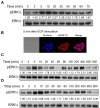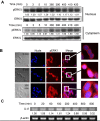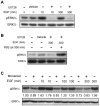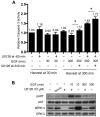Biphasic activation of extracellular signal-regulated kinase (ERK) 1/2 in epidermal growth factor (EGF)-stimulated SW480 colorectal cancer cells
- PMID: 26879318
- PMCID: PMC4915241
- DOI: 10.5483/bmbrep.2016.49.4.004
Biphasic activation of extracellular signal-regulated kinase (ERK) 1/2 in epidermal growth factor (EGF)-stimulated SW480 colorectal cancer cells
Abstract
Cancer cells have different characteristics due to the genetic differences where these unique features may strongly influence the effectiveness of therapeutic interventions. Here, we show that the spontaneous reactivation of extracellular signalregulated kinase (ERK), distinct from conventional ERK activation, represents a potent mechanism for cancer cell survival. We studied ERK1/2 activation in vitro in SW480 colorectal cancer cells. Although ERK signaling tends to be transiently activated, we observed the delayed reactivation of ERK1/2 in epidermal growth factor (EGF)-stimulated SW480 cells. This effect was observed even after EGF withdrawal. While phosphorylated ERK1/2 translocated into the nucleus following its primary activation, it remained in the cytoplasm during late-phase activation. The inhibition of primary ERK1/2 activation or protein trafficking, blocked reactivation and concurrently increased caspase 3 activity. Our results suggest that the biphasic activation of ERK1/2 plays a role in cancer cell survival; thus, regulation of ERK1/2 activation may improve the efficacy of cancer therapies that target ERK signaling. [BMB Reports 2016; 49(4): 220-225].
Figures




Similar articles
-
Both mitogen-activated protein kinase (MAPK)/extracellular-signal-regulated kinases (ERK) 1/2 and phosphatidylinositide-3-OH kinase (PI3K)/Akt pathways regulate activation of E-twenty-six (ETS)-like transcription factor 1 (Elk-1) in U138 glioblastoma cells.Int J Biochem Cell Biol. 2012 Feb;44(2):302-10. doi: 10.1016/j.biocel.2011.10.025. Epub 2011 Nov 7. Int J Biochem Cell Biol. 2012. PMID: 22085529
-
Grape seed extract inhibits EGF-induced and constitutively active mitogenic signaling but activates JNK in human prostate carcinoma DU145 cells: possible role in antiproliferation and apoptosis.Oncogene. 2003 Mar 6;22(9):1302-16. doi: 10.1038/sj.onc.1206265. Oncogene. 2003. PMID: 12618755
-
Sulindac sulfide inhibits epidermal growth factor-induced phosphorylation of extracellular-regulated kinase 1/2 and Bad in human colon cancer cells.Cancer Res. 2003 Feb 1;63(3):616-20. Cancer Res. 2003. PMID: 12566304
-
Lysophosphatidic acid signals through mitogen-activated protein kinase-extracellular signal regulated kinase in ovarian theca cells expressing the LPA1/edg2-receptor: involvement of a nonclassical pathway?Mol Endocrinol. 2003 Aug;17(8):1593-606. doi: 10.1210/me.2002-0371. Epub 2003 May 1. Mol Endocrinol. 2003. PMID: 12730329
-
ERK1/2-driven and MKP-mediated inhibition of EGF-induced ERK5 signaling in human proximal tubular cells.J Cell Physiol. 2007 Apr;211(1):88-100. doi: 10.1002/jcp.20909. J Cell Physiol. 2007. PMID: 17131384
Cited by
-
Design and development of novel, short, stable dynorphin-based opioid agonists for safer analgesic therapy.Front Pharmacol. 2023 Mar 3;14:1150313. doi: 10.3389/fphar.2023.1150313. eCollection 2023. Front Pharmacol. 2023. PMID: 36937883 Free PMC article.
-
Differential expression of DUSP2 in left- and right-sided colon cancer is associated with poor prognosis in colorectal cancer.Oncol Lett. 2018 Apr;15(4):4207-4214. doi: 10.3892/ol.2018.7881. Epub 2018 Jan 26. Oncol Lett. 2018. PMID: 29541187 Free PMC article.
-
Paxillin knockdown suppresses metastasis and epithelial‑mesenchymal transition in colorectal cancer via the ERK signalling pathway.Oncol Rep. 2020 Sep;44(3):1105-1115. doi: 10.3892/or.2020.7687. Epub 2020 Jul 14. Oncol Rep. 2020. PMID: 32705241 Free PMC article.
-
Caspase-2 mediates triglyceride (TG)-induced macrophage cell death.BMB Rep. 2017 Oct;50(10):510-515. doi: 10.5483/bmbrep.2017.50.10.106. BMB Rep. 2017. PMID: 28768565 Free PMC article.
-
Characterization and functional analysis of a slow-cycling subpopulation in colorectal cancer enriched by cell cycle inducer combined chemotherapy.Oncotarget. 2017 Jul 26;8(45):78466-78479. doi: 10.18632/oncotarget.19638. eCollection 2017 Oct 3. Oncotarget. 2017. PMID: 29108242 Free PMC article.
References
Publication types
MeSH terms
Substances
LinkOut - more resources
Full Text Sources
Other Literature Sources
Medical
Research Materials
Miscellaneous

